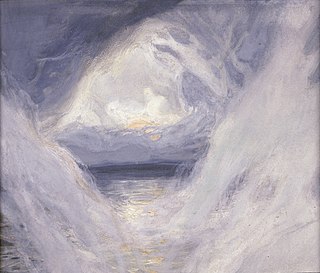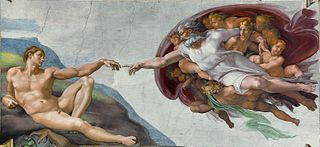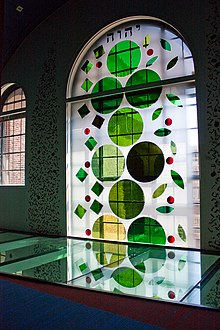A cosmological argument, in natural theology, is an argument which claims that the existence of God can be inferred from facts concerning causation, explanation, change, motion, contingency, dependency, or finitude with respect to the universe or some totality of objects. A cosmological argument can also sometimes be referred to as an argument from universal causation, an argument from first cause, the causal argument, or the prime mover argument. Whichever term is employed, there are two basic variants of the argument, each with subtle yet important distinctions: in esse (essentiality), and in fieri (becoming).
Creation or The Creation may refer to:

A creation myth or cosmogonic myth is a type of cosmogony, a symbolic narrative of how the world began and how people first came to inhabit it. While in popular usage the term myth often refers to false or fanciful stories, members of cultures often ascribe varying degrees of truth to their creation myths. In the society in which it is told, a creation myth is usually regarded as conveying profound truths – metaphorically, symbolically, historically, or literally. They are commonly, although not always, considered cosmogonical myths – that is, they describe the ordering of the cosmos from a state of chaos or amorphousness.
A creator deity or creator god is a deity responsible for the creation of the Earth, world, and universe in human religion and mythology. In monotheism, the single God is often also the creator. A number of monolatristic traditions separate a secondary creator from a primary transcendent being, identified as a primary creator.
Chaos is the mythological void state preceding the creation of the universe in Greek creation myths.
Creatio ex materia is the notion that the universe was formed out of eternal, pre-existing matter. This is in contrast to the notion of creatio ex nihilo, where the universe is created out of nothing. The idea of creatio ex materia is found in ancient near eastern cosmology, early Greek cosmology such as is in the works of Homer and Hesiod, and across the board in ancient Greek philosophy. It was also held by a few early Christians, although creatio ex nihilo was the dominant concept among such writers. At some point, creatio ex materia came to be accepted in Mormonism.

Religious cosmology is an explanation of the origin, evolution, and eventual fate of the universe from a religious perspective. This may include beliefs on origin in the form of a creation myth, subsequent evolution, current organizational form and nature, and eventual fate or destiny. There are various traditions in religion or religious mythology asserting how and why everything is the way it is and the significance of it all. Religious cosmologies describe the spatial lay-out of the universe in terms of the world in which people typically dwell as well as other dimensions, such as the seven dimensions of religion; these are ritual, experiential and emotional, narrative and mythical, doctrinal, ethical, social, and material.
The Genesis creation narrative is the creation myth of both Judaism and Christianity. The narrative is made up of two stories, roughly equivalent to the first two chapters of the Book of Genesis. In the first, Elohim creates the heavens and the Earth in six days, then rests on, blesses, and sanctifies the seventh. In the second story God creates Adam, the first man, from dust and places him in the Garden of Eden. There he is given dominion over the animals. Eve, the first woman, is created from Adam's rib as his companion.

The Kalam cosmological argument is a modern formulation of the cosmological argument for the existence of God. It is named after the Kalam, from which its key ideas originated. William Lane Craig was principally responsible for giving new life to the argument in the 20th century, due to his book The Kalām Cosmological Argument (1979), among other writings.

Genesis 1:1 is the first verse of the first chapter of the Book of Genesis in the Hebrew and Christian Bibles and the opening of the Genesis creation narrative.

In ancient near eastern cosmology, the firmament signified a cosmic barrier that separated the heavenly waters above from the Earth below. In biblical cosmology, the firmament is the vast solid dome created by God during the Genesis creation narrative to divide the primal sea into upper and lower portions so that the dry land could appear.

Thomas Jay Oord is a theologian, philosopher, and multidisciplinary scholar who directs a doctoral program at Northwind Theological Seminary and the Center for Open and Relational Theology. He formerly taught for sixteen years as a tenured professor at Northwest Nazarene University in Nampa, Idaho and before that a philosophy professor at Eastern Nazarene College. Oord is the author or editor of more than thirty books and hundreds of articles. He is known for his contributions to research on love, open theism, process theism, open and relational theology, postmodernism, the relationship between religion and science, Wesleyan, holiness, Nazarene theology.

Allegorical interpretations of Genesis are readings of the biblical Book of Genesis that treat elements of the narrative as symbols or types, rather than viewing them literally as recording historical events. Either way, Judaism and most sects of Christianity treat Genesis as canonical scripture, and believers generally regard it as having spiritual significance.
The Nāsadīya Sūkta, also known as the Hymn of Creation, is the 129th hymn of the 10th mandala of the Rigveda (10:129). It is concerned with cosmology and the origin of the universe.

Tohu wa-bohu or Tohu va-Vohu is a Biblical Hebrew phrase found in the Genesis creation narrative that describes the condition of the earth immediately before the creation of light in Genesis 1:3.
Since the emergence of the Big Bang theory as the dominant physical cosmological paradigm, there have been a variety of reactions by religious groups regarding its implications for religious cosmologies. Some accept the scientific evidence at face value, some seek to harmonize the Big Bang with their religious tenets, and some reject or ignore the evidence for the Big Bang theory.
Although biological evolution has been vocally opposed by some religious groups, many other groups accept the scientific position, sometimes with additions to allow for theological considerations. The positions of such groups are described by terms including "theistic evolution", "theistic evolutionism" or "evolutionary creation". Of all the religious groups included on the chart, Buddhists are the most accepting of evolution. Theistic evolutionists believe that there is a God, that God is the creator of the material universe and all life within, and that biological evolution is a natural process within that creation. Evolution, according to this view, is simply a tool that God employed to develop human life. According to the American Scientific Affiliation, a Christian organization of scientists:
A theory of theistic evolution (TE) — also called evolutionary creation — proposes that God's method of creation was to cleverly design a universe in which everything would naturally evolve. Usually the "evolution" in "theistic evolution" means Total Evolution — astronomical evolution and geological evolution plus chemical evolution and biological evolution — but it can refer only to biological evolution.

The meta-historical fall is an understanding of the biblical fall of man as a reality outside of empirical history that affects the entire history of the universe. This understanding of the human fall is a minority view among Christian theologians and associated by some with what they consider heresies, such as belief in the pre-existence of souls.
The Hexaemeron of Basil of Caesarea is a fourth-century Greek commentary on the Genesis creation narrative. It is the first known work in this genre by a Christian, although it was preceded by Jewish writings like the De opificio mundi of Philo of Alexandria in the 1st century AD and another, earlier lost work by Aristobulus of Alexandria in the 2nd century BC.
The Hexaemeron of Jacob of Serugh is a 6th-century text composed in the genre of Hexaemeral literature. As such, it offers a commentary on the Genesis creation narrative, and it is the first writing of this type to appear in the Syriac language. There was some precedent in the Commentary on Genesis by Ephrem the Syrian, but this was not a Hexaemeron. Likewise, there is no evident influence of a potential Syriac translation of the Hexaemeron of Basil of Caesarea on Jacob's work. Jacob dedicated a separate homily for each day of the creation week.










